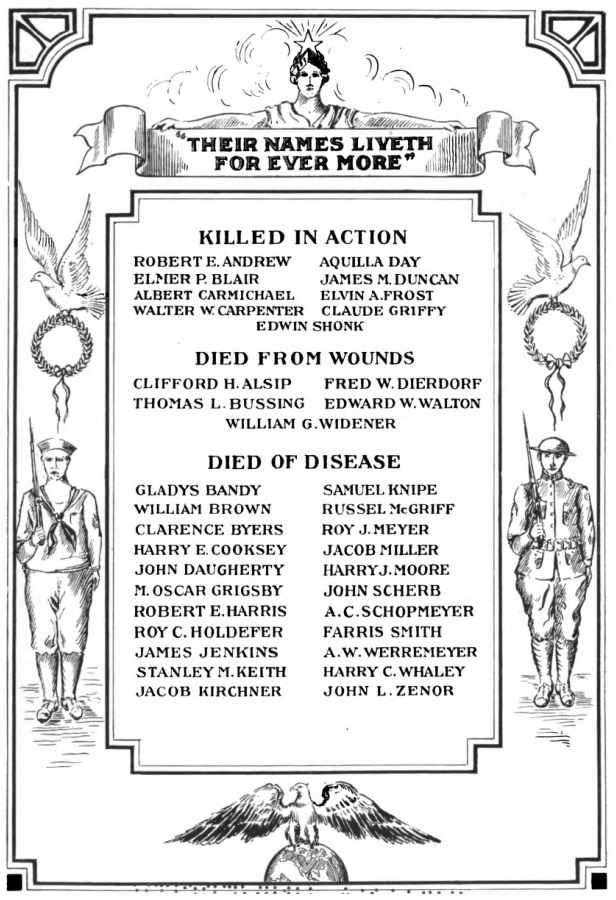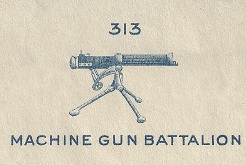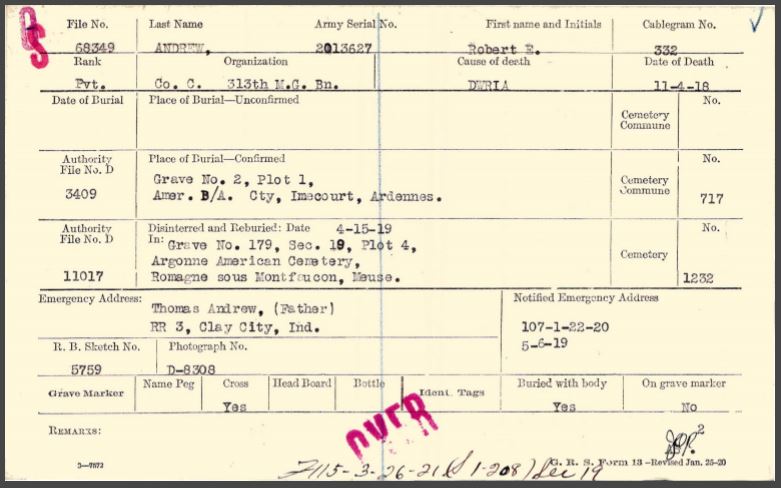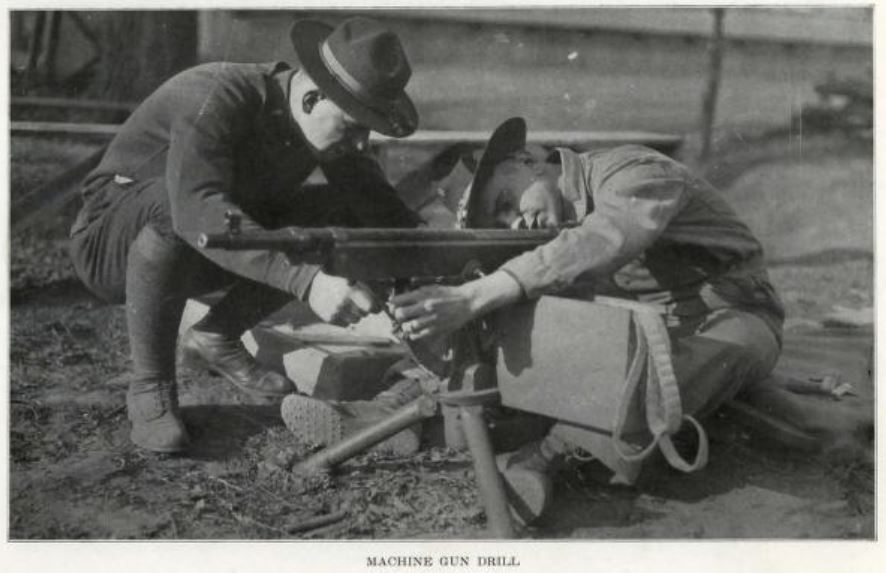Robert Eldon Andrew
“The details of this brave young soldier’s death, the battle in which he received his wounds, the hospital where he spent his last hours, are all unknown to his family.” These words appear in the bio for Robert E. Andrew, when the people of Clay County, Indiana initially published a commemorative book to honor all those from the county who served in the World War. At the time this commemorative book was published, the 313th Machine Gun Battalion was not listed as a unit for Private Andrew.
Being one of the soldiers who arrived in France with a different Division, and later being attached to the 313th Machine Gun Battalion, it is possible that his family had not yet heard of the unit to unit transfer until months, or even years later. It was only recently, that I learned of the history of Private Robert E. Andrew, and his affiliation with the 313th Machine Gun Battalion. He became known to me after searching the "Burial Cards" that are available on the National Archives website.
However, credit must be given to Weldon Hoppe, who I met on the Meuse-Argonne.com Facebook group site, who graciously assisted me in searching the burial cards in order to compare the data reported in the 80th Division's Summary of Operations with the data I have collected from countless sources over my years of research. I was surprised that Private Andrew's record as a casualty was not even recorded in the boxes of records that I searched at the National Archives II in College Park, Maryland. I regret that his name was not included in my book, but I am grateful that his family and his community did honor his sacrifice and service. #LestWeForget

Robert Eldon Andrew, son of Thomas and Molly Andrew, was born at their family home in Harrison Township on January 16, 1895. The family lived close to Clay City in Clay County, Indiana, where Robert entered Clay City High School in 1911. He was said to have excelled in athletics and graduated from the school in 1915. Following graduation, he took a position as a teacher in the Osenbrook, North Dakota, and later moved to teach school in Cleveland, Oklahoma. In June 1917, when the national draft took place and school was out of session, Robert registered for the national draft and listed his occupation at that time as a self-employed coal miner. Almost a year later he was inducted into the Army on May 4, 1918, in Brazil, Indiana and was sent to Camp Taylor, Kentucky with a contingent of other Clay County men. It was at Camp Taylor that he was assigned to the 30th Company, 8th Battalion, 159th Depot Brigade. He was transferred to Camp Beauregard, Louisiana, where he was assigned to a Machine Gun Company in the 153rd Infantry, 39th Division. He sailed to France with this unit on August 6, 1918, aboard the U.S. transport Huron.
It is unclear when he was assigned to C Company, 313th Machine Gun Battalion. His name does appear on the muster roll with this battalion recorded on the “last day of October 1918.” Private Andrew was wounded on November 3, 1918, and died of his wounds on November 4, 1918. His first burial took place in Imecourt, Ardennes, and was later disinterred and reburied on April 15, 1919, in the American Cemetery in Romagne sous Montfaucon, Meuse. As the family was given a choice on what to do with his body, he was disinterred from the American Cemetery and shipped back to the United States on August 6, 1921, aboard the US Wheaton. His final resting place is located in Beech Cemetery, Coal City, Indiana. He was the only Clay City High School graduate to lose his life in the First War.
Machine Gun Training at Camp Taylor
The Terre Haute Tribune-Star, Terre Haute, Indiana reported, "On Monday, Nov. 11, 1919, at about 2:30 a.m., a series of industrial whistles rattled the air in the northeastern part of Terre Haute. Then, one by one, other whistles, and bells, joined them. Finally, the big bass horn at the government distillery on First Street sounded and all other sounds were lost. Auto horns soon joined the cacophony and the whole city, it seemed, awakened to a celebration. By 7:25 a.m., a parade of men from the Pennsylvania Shops and a large throng of miners were parading westward down Wabash Avenue. The chapel at Indiana State Normal School was filled to capacity. After leading students in singing the national anthem, President William W. Parsons read portions of the armistice which ended the World War. Another parade began at 10 a.m. headed by President Parsons and a drum corps composed of Professor Victor Miller, fifer; and Normal Library custodian Charlie Call, drummer. Starting at Sixth Street, the procession went west to Fifth Street, south to Cherry, west to Fourth Street, south to Wabash, east to Ninth Street and back to Sixth Street. Loads of scrap paper and paper streamers were unleashed from the top floors of the Terre Haute Trust Co. building at the southeast corner of Seventh and Wabash.
There was a moment of silence to honor the former Indiana State students who lost their lives in the war: Lt. Arthur Schopmeyer, Sgt. Paul Duck, Cadet Charles B. Passwater, Robert E. Andrew, Clarence Beall, Robert Bennett, Forrest Clyde Bultman, Byron Cox, Ben Davis, John L. Flick, Herbert Huck, Basil LaFollett, Doyle Benton McAdams, Guy S. McClanahan, Lercy Mann, Leonard Patterson and Floyd Pound."



